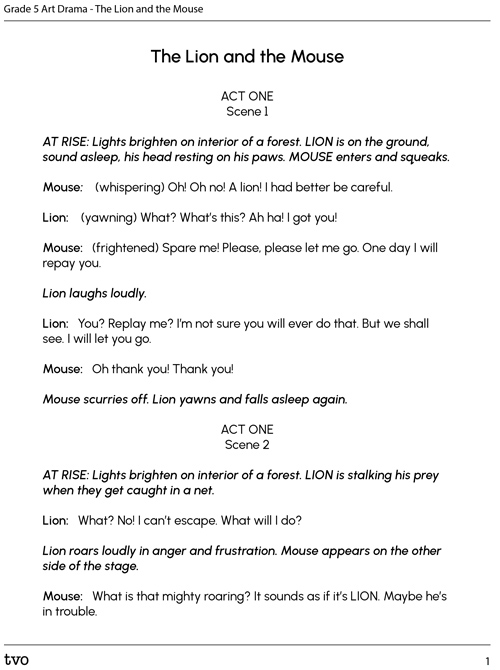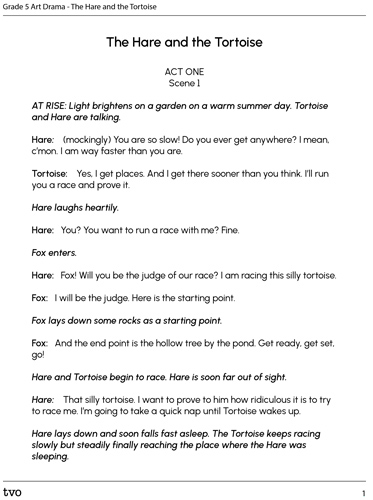Minds On
Warm up
Before you begin, don't forget to do your safety check!
Warm Up
Breathing exercise

Find a comfortable position. Focus your attention on one part of the body at a time.
How does that part of your body feel? If possible, take a deep breath and allow your lungs to expand.
Focus your attention on one part of your body. Allow that part to relax before moving on to the next. As you scan through your body, keep breathing deeply. Once you have completed the scan, take a moment to stretch.
If you wish, you can access this recording entitled Deep Breathing to complete your breathing activity.
Deep Breathing
Drama game
Imagine that you are a tree, beginning its life as a seed pod. Explore the following audio clip and practise visualizing, moving, or even just exploring the process of growing through the seasons in your own way.

|
Forest Day |
Reflect on your experience using the questions below to guide you. Share your thoughts with a partner, if possible.
- How did you feel when you grew out of the seed pod?
- What was it like when you first experienced the sun?
- How did it feel in role as the growing tree? Did you feel strong? Powerful? Vulnerable?
Let’s get started
Explore the stage set-up below. What do you notice about the set-up?
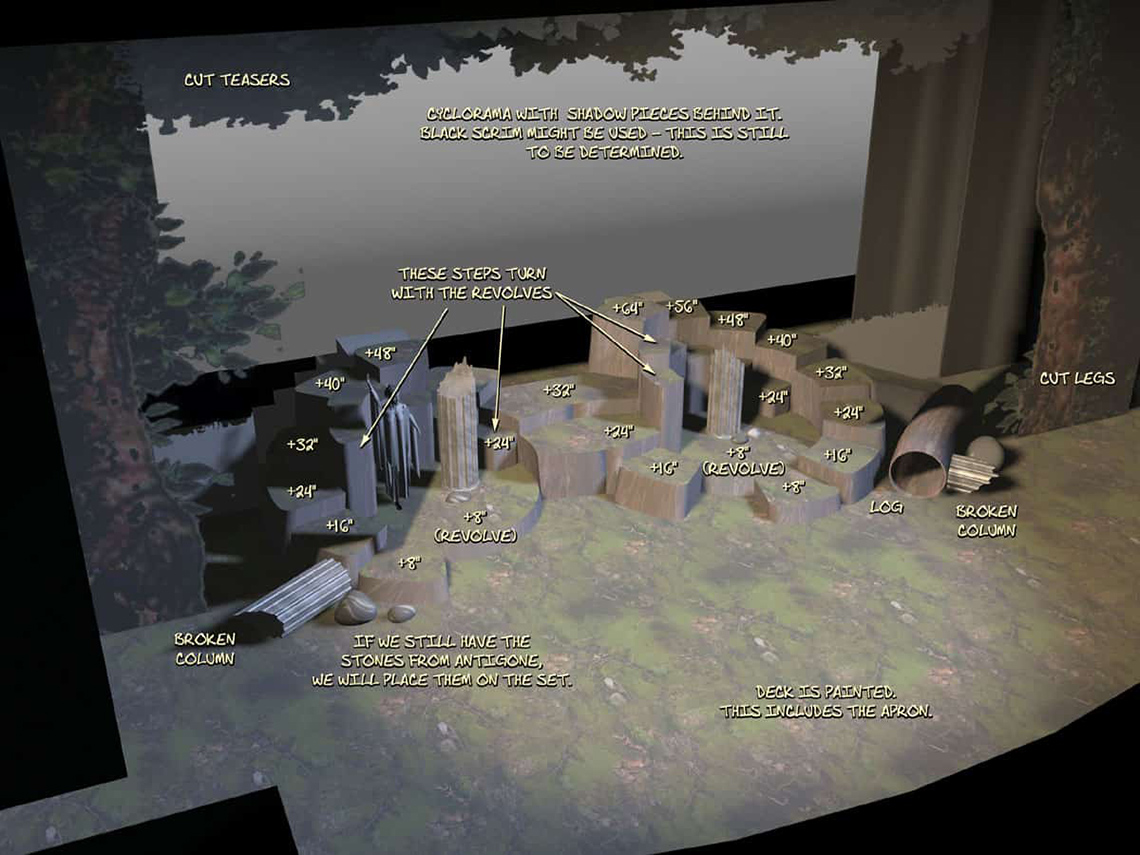
Matt Kizer's scenic design, lighting design and projections for the Plymouth State University production of A Midsummer Night's Dream, 2007
A stage that has not been set up yet. There are various props, like stones and pillars ready to be placed around the stage. The lighting is facing down, directly from the center of the stage. There is a black background and trees lining the edges of the stage.
Now, explore the stage after it has been transformed by the crew.
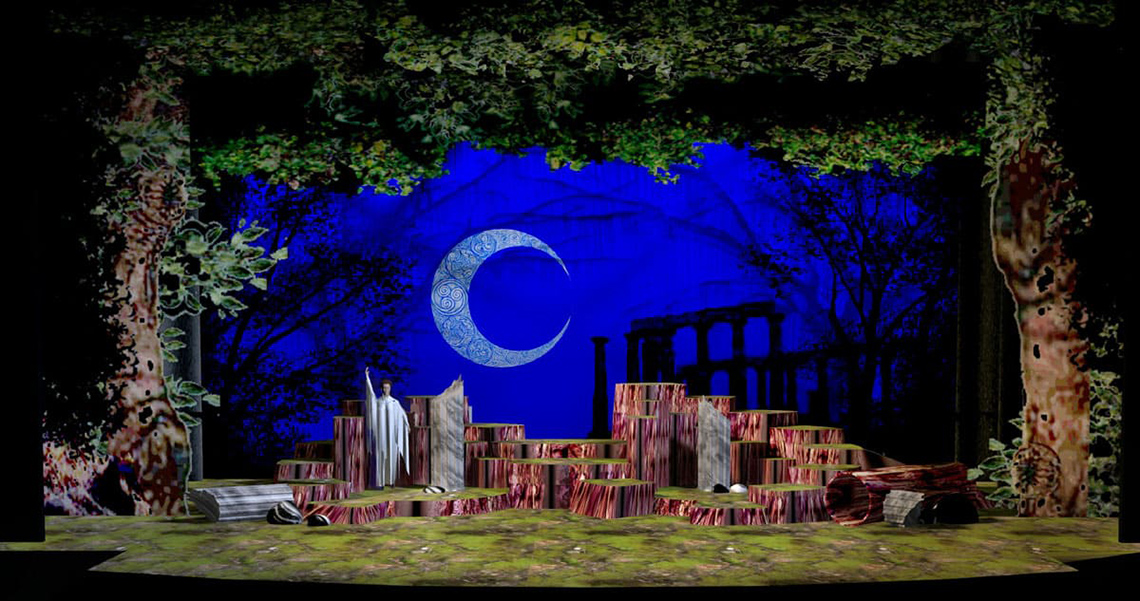
Matt Kizer's stage set-up for the Plymouth State University production of A Midsummer Night's Dream, 2007
A stage that has been set up. The rocks and pillars have been organized on the stage, with a person standing on one rock. The lighting now covers the whole stage. The black background has been transformed to be a dark blue with a pale moon on it.
What do you notice about the stage now that it has been set? Based on the clues provided, what might be the setting of the play?
Record your ideas in writing, digitally, or as an audio recording.
Action
Get ready, get set…
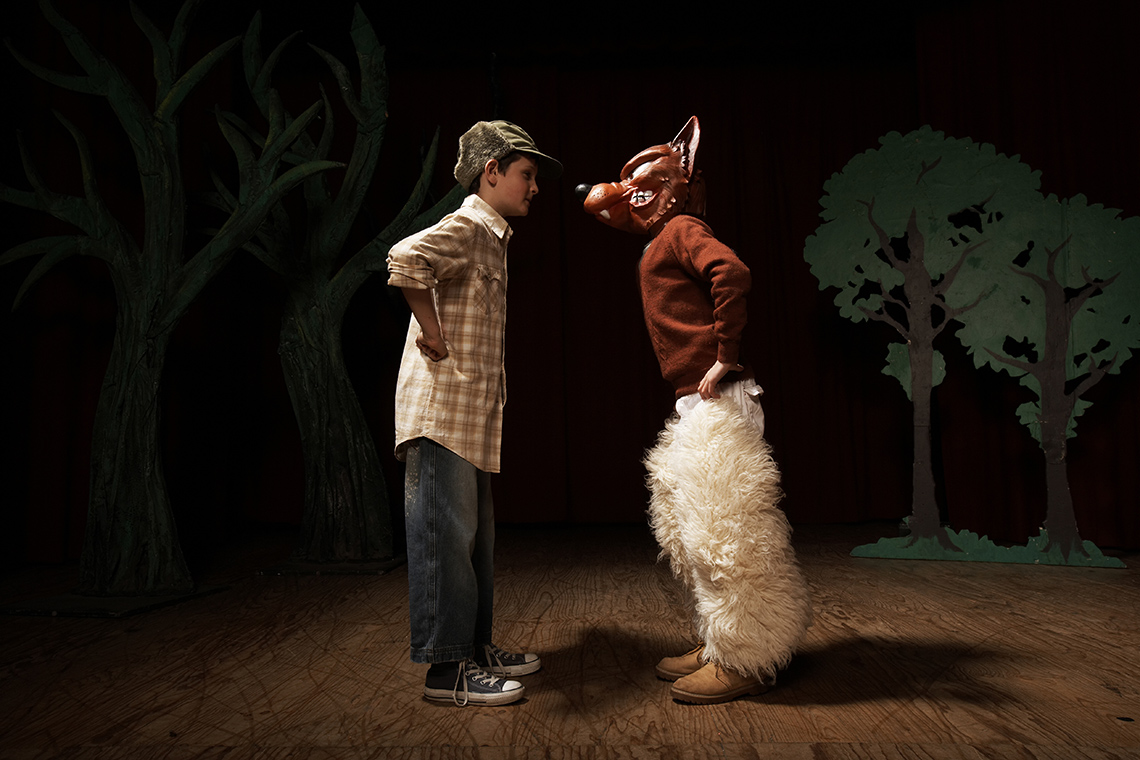
In a drama production, lighting design, projection design, and scenic design come together to create a mood or atmosphere in a drama production. These stage effects can change from scene to scene, creating suspense and excitement, or happiness and calm for the audience.
Explore the following videos to understand the different roles of a lighting designer, projection designer, and scenic designer.
Lighting design
Explore the following video about how lighting designers work with actors to develop scenes.
Now that you have explored the video, answer the following questions:
- What does it mean to sculpt using light?
- Why is the job of a lighting designer important to a drama production?
- Who do the lighting designers work with to develop a plan for each scene?
Press ‘Hint’ to explore some suggested answers and check your work.
- This might mean that the lighting designers would like the audience to experience the show in certain ways. They sculpt or reveal particular parts of the stage and the actors onstage in different ways throughout the show. This helps to enhance the story being told.
- The lighting designer helps the audience to focus on where the action is taking place and follow that action throughout each scene.
- The lighting designers work with the director, set or scenic designers, and costume designers for a number of days or weeks. They also work directly with the actors.
Projection design
Explore the following videos to experience how a projection designer creates different stage effects to enhance a production.
Now that you have explored the video, answer the following questions:
- What is the projection designer doing to create effects in the studio?
- What kind of effect is the projection designer trying to create for the drama production Fortress of Solitude?
- What is the overall goal for all the parts of the projection?
Press ‘Hint’ to access a suggested answer and check your work.
- He is using silhouette cutouts and light to create shadow puppets.
- They want the media to look handmade. They will use a combination of silhouette cutout puppetry, stop-and-go animation, and add some of these pieces to green screen to make it appear like it was created by an overhead projector as shadow play.
- The overall goal is for all the parts of the projection to look consistent and enhance the drama production.
Scenic design
Explore the following video to experience how a scenic designer creates the set.
Now that you have explored the video, answer the following questions:
- What does a scenic designer do at the beginning of designing for a play?
- What is the scenic designer’s process for creating the set?
Press ‘Hint’ to access a suggested answer and check your work.
- They read it and then speak to the director to get a sense of the director’s creative vision.
- They start by creating a basic model and have that in the background of their studio. After about a week, they decide on potential changes and start to work to complete the model. Next, they create a set of technical drawings for all the parts of the set that need to be built. Then, they send that to the shop where the full-scale set is created and then taken apart. It is brought into the theatre and assembled on stage. Then, the lighting designers, sound designers, and actors get to experience the set and figure out what works and what does not work. Finally, the scenic designer can decide if anything needs to be modified or changed.
Bring it all together
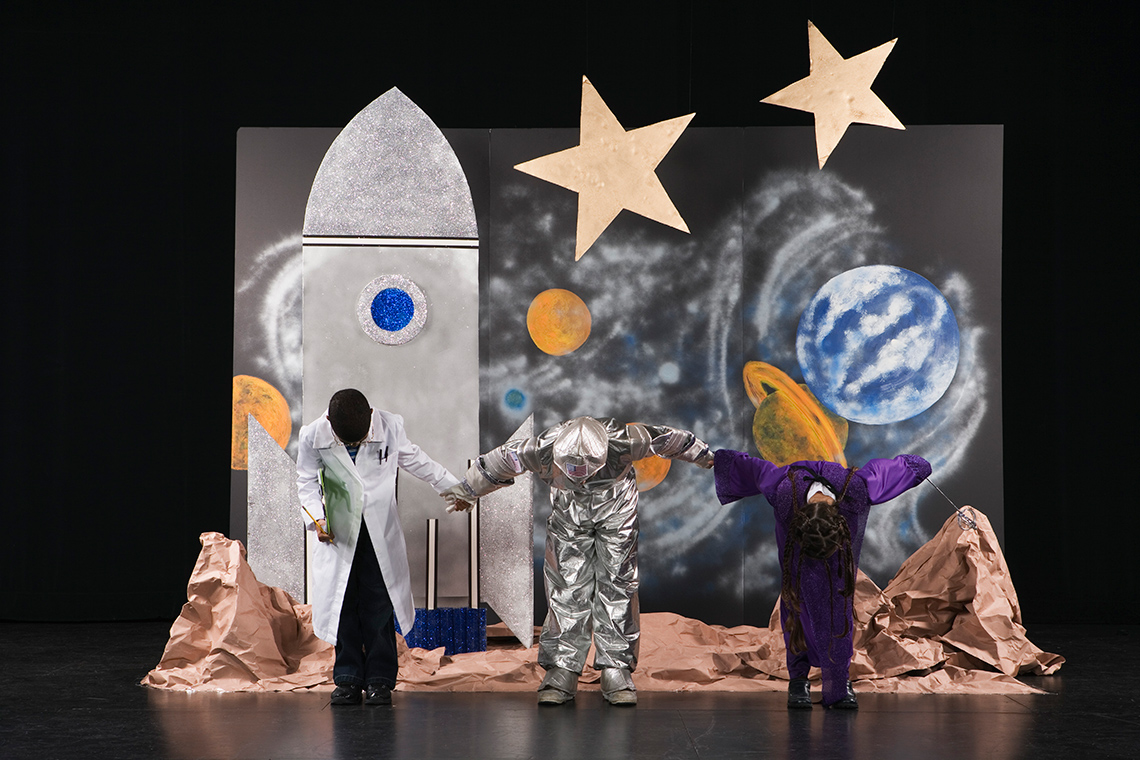
All three designers might come together to work on creating specific scenes in a drama production to convey a certain mood to the audience, work on transitions from scene to scene, and explore different options that help keep the audience engaged in the drama production.
Changing the backdrop and props in the setting, adjusting the lighting to depict moving from day to night, and using projection design to enhance the stage all help to create a more exciting and engaging drama production.
Let’s explore an example of a drama production that required all three designers to work together or collaborate. On the Town, was written to include different painted backdrops that would change from scene to scene.
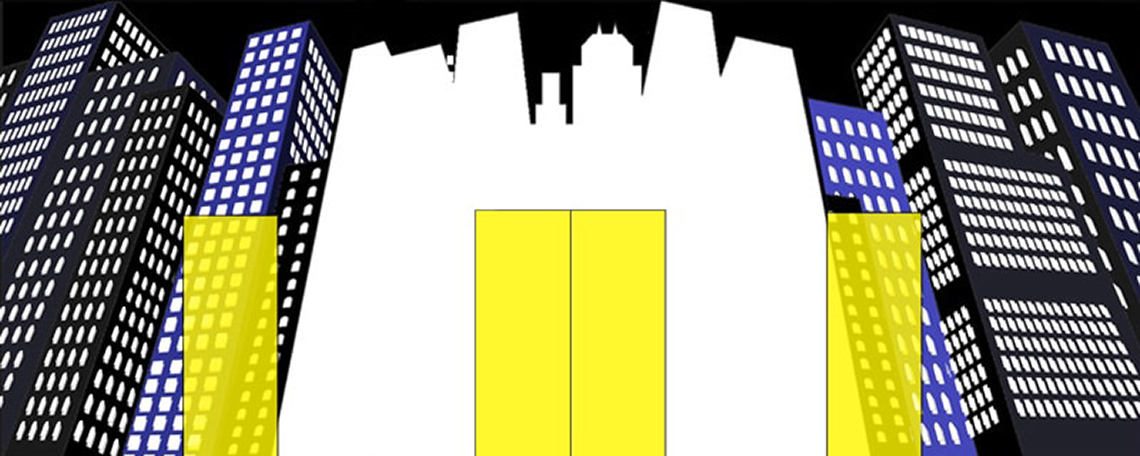
The yellow rectangles indicate doors. These doors will not appear unless they are opened and blended into the background created.
Matt Kizer's set background design for the North Country Center for the Arts: Papermill Theatre production of On The Town, 2009
A stage background with a city outline. In the foreground is a large building. There are four yellow-coloured rectangles in the middle, distinct from the rest of the image. These represent hidden doors on stage background and they blend into the background.
How might a projection designer come together with a lighting and scenic designer to help simplify the creation of a set that changes settings often?
Press ‘Hint’ to access a suggested answer.
Instead of creating multiple separate backgrounds, background projections could be used instead!
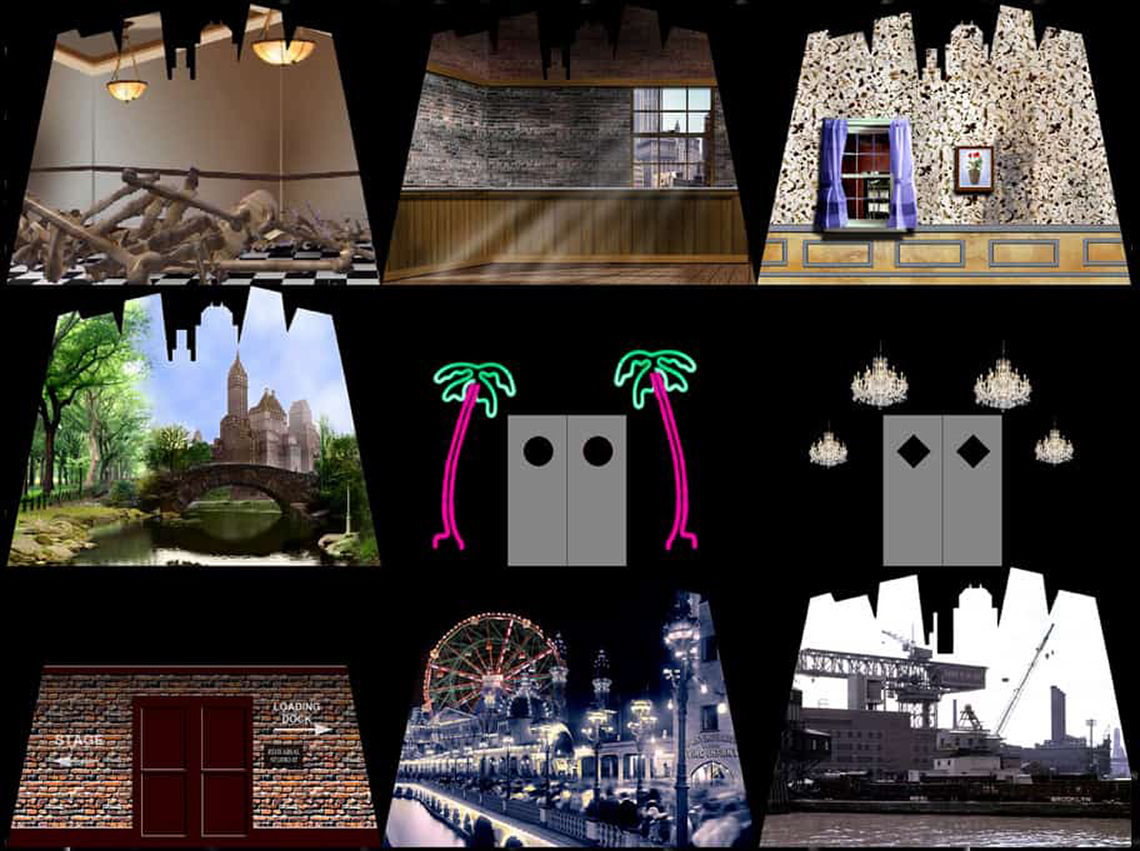
Matt Kizer's projection designs for the North Country Center for the Arts: Papermill Theatre production of On The Town, 2009
The drama production On the Town is a musical. Having projected backgrounds gave the actors more space to move around, specifically for dance performances. It also allowed more rooms of additional props.
The scenic designer and projection designer might discuss the overall design for the sets, and then they worked together to create a projection. Additionally, the lighting designer might help in adjusting the lighting on stage and making sure to create moving spotlights on the actors as they performed on stage.
Examine the projected backgrounds. How might the mood of the scene change as the background changes?
Go!
Let’s try to take the story of “The Lion and the Mouse,” adapted from Aesop’s Fables, and use what we have learned about stage effects to transform the story into a plan for a stage production.
First, explore the following story the “The Lion and the Mouse” by Aesop’s Fables.
“The Lion and the Mouse”
A Lion lay asleep in the forest, his great head resting on his paws. A timid little Mouse came upon him unexpectedly, and in her fright and haste to get away, ran across the Lion’s nose. Roused from his nap, the Lion laid his huge paw angrily on the tiny creature.

“Spare me!” begged the poor Mouse. “Please let me go and some day I will surely repay you.”
The Lion was much amused to think that a Mouse could ever help him. But he was generous and finally let the Mouse go.
Some days later, while stalking his prey in the forest, the Lion was caught in the toils of a leftover fishing net. Unable to free himself, he filled the forest with his angry roaring. The Mouse knew the voice and quickly found the Lion struggling in the net. Running to one of the great ropes that bound him, she gnawed it until it parted, and soon the Lion was free.
“You laughed when I said I would repay you,” said the Mouse. “Now you see that even a Mouse can help a Lion.”
– Aesop’s Fables
Next, explore the story in script format.
Creating stage effects

Consider the following questions about stage effects for a production of “The Lion and the Mouse.” What might each designer include to enhance a production (e.g., backdrop, lighting, projections)?
What kind of a backdrop might be created?
Press ‘Hint’ to access a suggested answer.
I would use a forest backdrop. I would add a few freestanding trees as well.
How might the lighting change from scene to scene?
Press ‘Hint’ to access a suggested answer.
At the beginning of the play, the lion is sleeping. I would use dimmer lights to illuminate the stage, and then make the lighting brighter in Act 2 since it is during the daytime.
Is there anything that could be projected to enhance the set?
Press ‘Hint’ to access a suggested answer.
Since the play is set in the forest, I might project the shadows of different animals. These animals would change throughout the production.
Consolidation
Putting it all together
Imagine you were able to work on helping the scenic designer, lighting designer, and projection designer on a production of “The Hare & the Tortoise.” Explore the story and script below, and then consider how you might stage this production. You may also select another story and script of your choice.

“The Hare & the Tortoise”
A Hare was making comments about the Tortoise and how the Tortoise moves slower than then they do. The Tortoise challenged the Hare to a race. The Hare was much amused at the idea of running a race with the Tortoise, but for the fun of the thing he agreed.
The Fox, who had agreed to act as judge, marked the distance and started the race.
The Hare was soon far out of sight, and to make the Tortoise feel very deeply how ridiculous it was for him to try a race with a Hare, he lay down beside the course to take a nap until the Tortoise should catch up.
The Tortoise meanwhile kept going slowly but steadily, and, after a time, passed the place where the Hare was sleeping. But the Hare slept on very peacefully; and when at last he did wake up, the Tortoise was near the goal. The Hare now ran his swiftest, but he could not overtake the Tortoise in time.
Lesson: The race is not always to the swift.
– Aesop’s Fables
Explore the following script for the fable “The Hare & the Tortoise”
Portfolio
From script to stage
Create a plan using the following template for how you would stage your production. You may also create a detailed description or an audio recording.
Use the following questions to guide you:
- Would you use a backdrop? If so, would you add any other freestanding props to the stage?
- How might the lighting change from scene to scene?
- Is there anything you would like to project in the background?
Complete the Stage Plan in your notebook or using the following fillable and printable document. If you would like, you can use speech-to-text or audio recording tools to record your thoughts. Consider adding your work to your drama portfolio.
|
Stage effects |
Notes |
Drawing |
|---|---|---|
|
Scenic design |
||
|
Lighting design |
||
|
Projection design |
Press the ‘Activity’ button to access Stage Plan.
Optional: Create a model of the set
Create a diorama model of your set! You may also create a digital diorama using a digital application of your choice.
A diorama is a 3-dimensional model. In your diorama, you may include models of your backdrop, props, and stage set-up. Consider if you want a part of the stage clear to create projections.
Explore the possible materials you could use to create a model of the set.
Possible materials
Once you have completed your diorama, use a flashlight or another light source to play with different kinds of lighting. Next, you might create shadow puppets to project in the background of your stage.
Press ‘Explore’ to return to the video of shadow puppetry. You might use the video as inspiration.
Reflection
As you read through these descriptions, which sentence best describes how you are feeling about your understanding of this learning activity? Press the button that is beside this sentence.
I feel...
Now, record your ideas using a voice recorder, speech-to-text, or writing tool.
